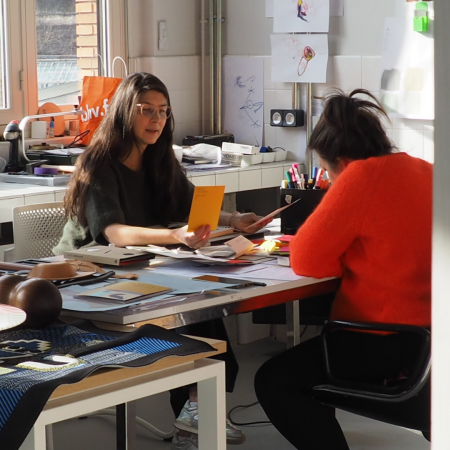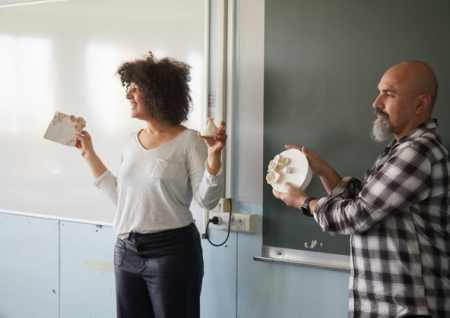
Albane Salmon, sculpter le bois, sublimer la matière.
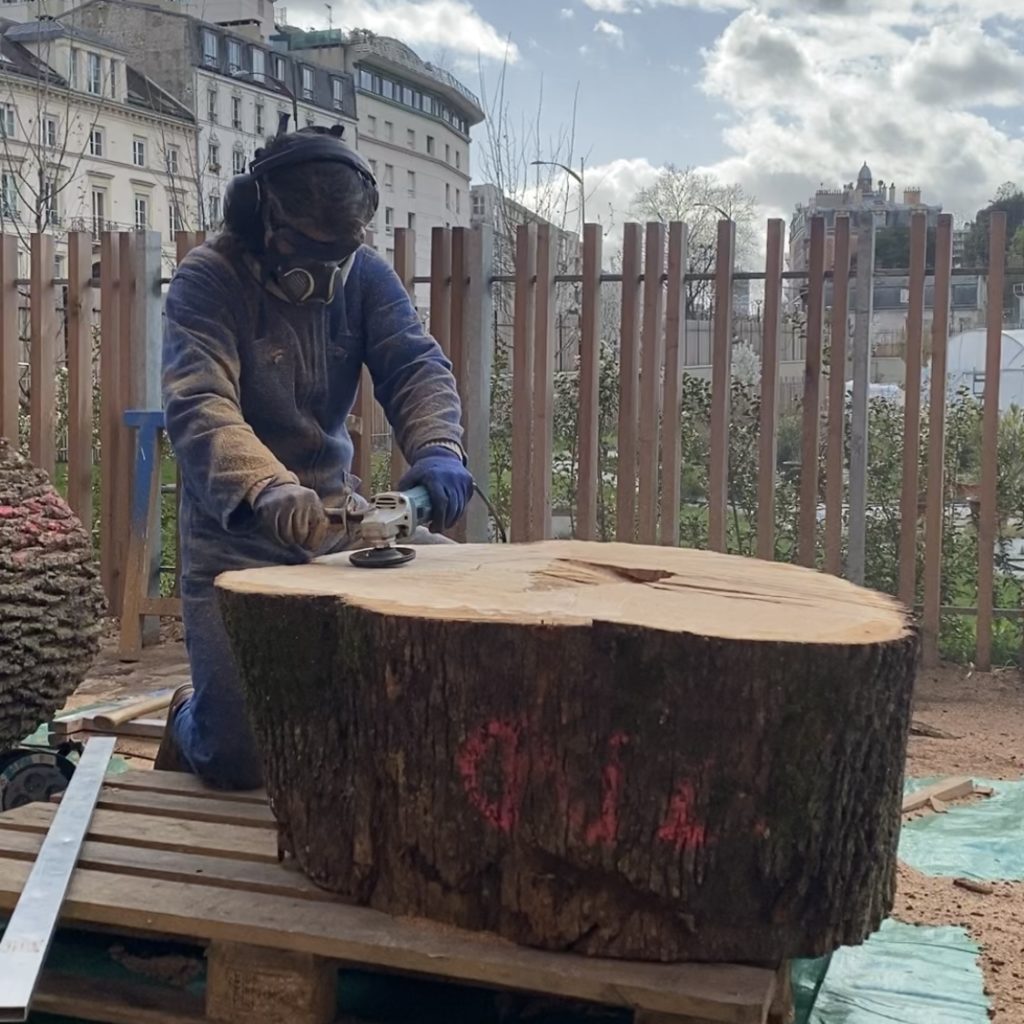
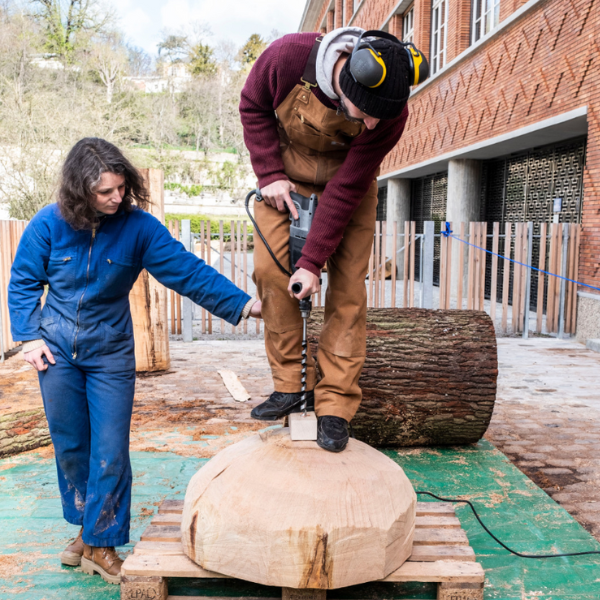
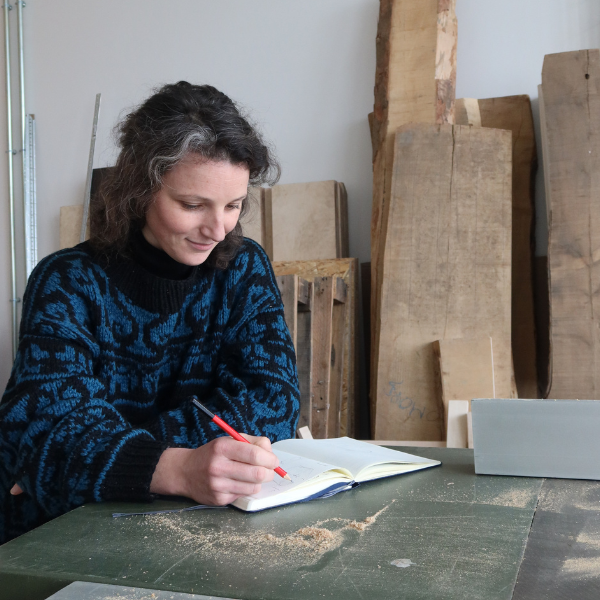
Albane Salmon est ébéniste. Sous le nom d’Atelier Sauvage, elle développe une esthétique inspirée de la nature et crée des pièces en bois massif à la frontière entre sculpture et élément de mobilier. Installée au JAD depuis décembre 2022, elle entend y affirmer sa démarche de création et la nourrir de la collaboration avec les autres artisans d’art et designers.
Dans cette perspective et à l’occasion du Printemps de la Sculpture (24 – 26 mars 2023), Albane Salmon a amorcé la réalisation d’une sculpture monumentale en collaboration avec le sculpteur sur bois Maxime Perrolle, lors d’un live sculpture ouvert au grand public. Du 1er au 4 juin 2023, son travail sera également exposé dans le cadre de la Biennale Emergences à Pantin. L’occasion pour Albane Salmon de revenir sur son parcours et de raconter son projet d’atelier ainsi que sa vie au JAD.
En quoi consiste l’événement que vous avez proposé au JAD pour le Printemps de la Sculpture ? Comment ce projet de sculpture monumentale s’inscrit-il dans votre démarche de création ?
Le Printemps de la Sculpture est un événement porté par les départements des Hauts-de-Seine et des Yvelines. Lors d’un week-end – cette année du 24 au 26 mars – le grand public est invité à découvrir la sculpture sous toutes ses formes, du patrimoine ancien à la création contemporaine. Aux côtés du Musée Rodin de Meudon, de la Manufacture de Sèvres ou encore du Château de Sceaux, le JAD a donc porté sa vision de la sculpture, empreinte du dialogue entre métiers d’art et design et de l’hybridation des savoir-faire. C’est ainsi que Maxime Perrolle et moi avons proposé au public un live sculpture, au cours duquel nous avons amorcé la conception d’une sculpture monumentale sur laquelle nous allons continuer à travailler dans les mois qui viennent et que nous espérons terminer d’ici à septembre 2023.
Ce projet prend racine dans notre volonté commune à Maxime et moi de changer d’échelle en travaillant sur une sculpture aux dimensions imposantes, ce qui nous sort de notre zone de confort et constitue une véritable exploration sur le plan technique. De plus, le fait de travailler à un projet de création relevant davantage de l’abstraction formelle que de l’objet fonctionnel fait écho à la démarche de Maxime ainsi qu’à la mienne. En effet, si je réalise essentiellement des pièces de mobilier fonctionnelles, mon approche du travail du bois s’apparente en réalité davantage à la sculpture qu’à l’ébénisterie au sens traditionnel du terme.
Par ailleurs, ce projet de création se nourrit du territoire du JAD. La sculpture est en effet réalisée à partir de tronçons de chênes d’un très bel âge, issus du domaine de Saint-Cloud, dont les serres font face aux bâtiments du JAD. De plus, d’un point de vue formel, cette sculpture s’inspire des emboîtements et des formes totémiques qu’Ettore Sottsass a créés dans les années 1990 à la Cité de la Céramique, voisine du JAD. Nous avons voulu rester proches des formats initiaux de ces tronçons massifs, afin de laisser deviner les arbres derrière ces pièces de bois, et de leur rendre hommage.
Comment est née cette vocation pour le travail du bois ?
Au départ ce n’est pas à l’ébénisterie que je me destinais, mais j’ai rapidement été attirée par le travail de la matière. J’ai grandi dans les Alpes, dans un environnement familial et social où la culture du faire était centrale. Le bois en particulier m’attirait et j’avais l’intuition que le mobilier pouvait être un vecteur de création dans lequel je m’épanouirais.
En 2015, j’ai donc suivi un CAP d’ébénisterie en cours du soir avec la Mairie de Paris. C’est dans ce cadre que j’ai rencontré Paul Demarquet avec qui j’ai cofondé Atelier Sauvage autour d’une démarche commune : celle de créer du mobilier en associant artisanat d’art et design. Ensemble, nous avons beaucoup appris en faisant, une démarche que je poursuis aujourd’hui encore, considérant que tout est perfectible et qu’il y a toujours matière à apprendre et à améliorer.
Comment décririez-vous la démarche que vous menez au sein d’Atelier Sauvage ? Quels sont les principes ou éléments récurrents qui structurent votre travail de création ?
Je travaille essentiellement sur des objets en bois massif à la croisée de la sculpture et du mobilier. J’accorde une attention toute particulière au matériau : en plus de privilégier des essences qui poussent localement, je travaille le bois dans la masse car cela me permet d’aller dans son épaisseur et de le modeler pour donner vie à des courbes, des arrondis. Mon approche est donc davantage celle d’une sculptrice que d’une ébéniste, plus à la recherche de la poésie et de l’immédiateté du rapport au matériau qu’à la poursuite de la prouesse technique.

Mon travail se caractérise aussi par l’utilisation de la couleur. Le travail du bois teinté fait partie intégrante de l’esthétique que je développe. Je collabore notamment avec Marie de Lignerolles, artiste, illustratrice, coloriste et designer.
En travaillant selon le principe du cadavre exquis, nous avons dessiné ensemble une série de sculptures lumineuses en bois teintées, inspirées des gouaches découpées de Marie. Ce travail commun a été présenté en 2021 à la Galerie Chapelle XIV. Je m’interroge aujourd’hui sur la provenance des colorants et des pigments que j’utilise et sur la pertinence d’appliquer au travail du bois des techniques de teinture et d’encre végétales.
Quelles sont vos méthodes de création, vos sources d’inspiration ?
Je privilégie dans mon travail une création contextualisée : partir de contraintes stimule ma créativité et mon imagination. A titre d’exemple, lorsque j’ai réalisé le mobilier de l’Hôtel de Ville de Pantin, je me suis inspirée d’une fresque représentant une scène d’Arcadie peinte sur les murs, en en reprenant les couleurs pour créer un lien entre le décor XIXe de la salle et le parti pris contemporain du mobilier. Ce projet est d’ailleurs assez représentatif de ce qui nourrit ma créativité : la nature, la peinture et l’art sous toutes ses formes.
La nature, ses couleurs et sa façon de façonner l’environnement m’inspirent beaucoup dans mon travail de création. Je m’attache notamment à retranscrire certains phénomènes comme l’érosion, les galets lissés par les eaux, des phénomènes qui rendent la nature encore plus belle et intéressante car ils lui confèrent une histoire et m’émeuvent beaucoup.
Je m’inspire également des travaux d’artistes comme Matisse , de sculpteurs comme Noguchi, JB Blunk ou Brancusi, ou encore de disciplines comme la tapisserie et la céramique. Toutes nourrissent mes recherches autour des couleurs et mon approche formelle des objets.
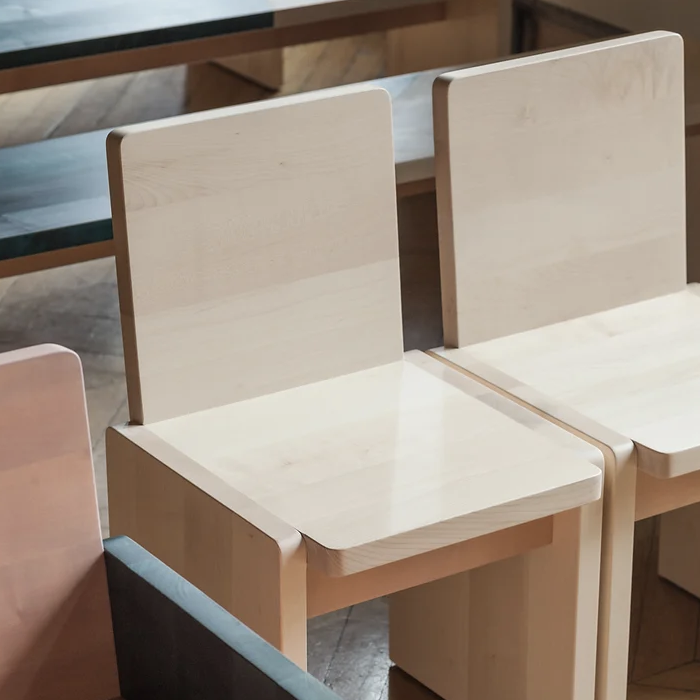
Mobilier en érable sycomore partiellement teinté, finition huilée, 2017
Design Albane Salmon pour Atelier Sauvage
Fabrication Albane Salmon et Paul Demarquet pour Atelier Sauvage
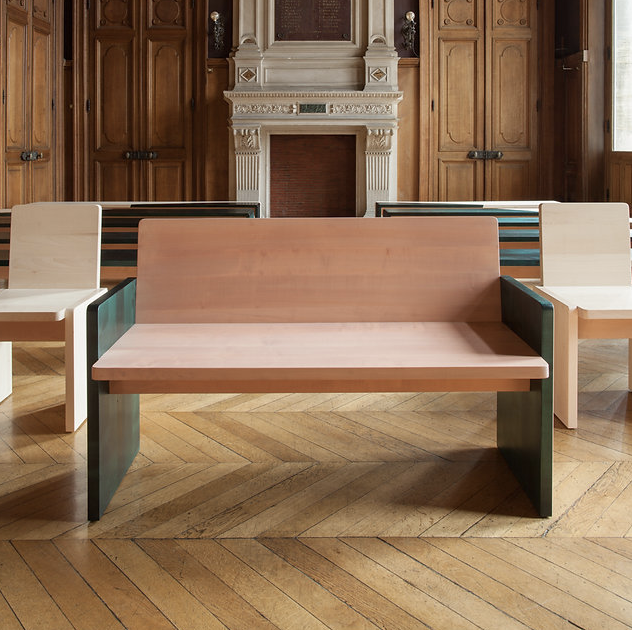
SALLE DES MARIAGES, HOTEL DE VILLE DE PANTIN
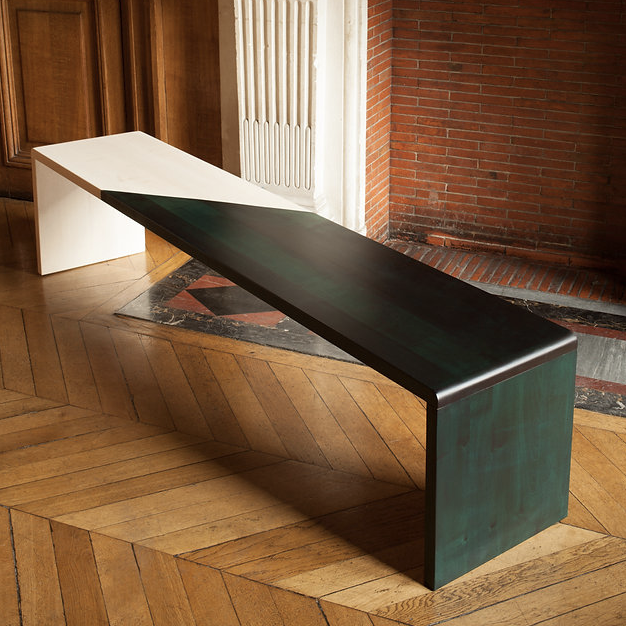
Photos: Mario Simon Lafleur
Comment le JAD s’inscrit-il dans votre parcours et votre démarche de recherche et de création ?
J’ai toujours pratiqué le travail en collaboration, de la fondation d’Atelier Sauvage avec Paul Demarquet, aux recherches que je mène en dialogue avec Marie de Lignerolles autour de la couleur. Cette démarche, je la poursuis aujourd’hui au JAD où je me suis installée en décembre 2022. Je m’y nourris de la proximité avec les autres artisans d’art et designers, et en particulier de la présence d’autres savoir-faire comme le tissage que j’aimerais croiser avec mon travail du bois pour donner vie à un matériau hybride aux propriétés innovantes.
Par ailleurs, le JAD se donne pour mission de sensibiliser le grand public aux enjeux de dialogue entre métiers d’art et design. Cette dimension du projet me tient beaucoup à cœur. C’est aussi dans cette perspective que Maxime et moi avons proposé le live sculpture lors du Printemps de la Sculpture : réaliser en public une sculpture monumentale qui sera à terme exposée en extérieur est à mon sens une manière de mettre un peu de poésie dans le quotidien. C’est aussi l’occasion de montrer la fabrication, et d’inspirer la jeune génération en montrant que la création est au cœur de nos métiers.
Entretien mené par Brune Schlosser
Chargée de projets culturels et patrimoniaux à l’INMA
et correspondante INMA au JAD
Sur la même thématique

Matière à Penser, un programme d'excellence dédié aux métiers d'art

Recherche autour du kaolin, un workshop mené avec l'Ensaama
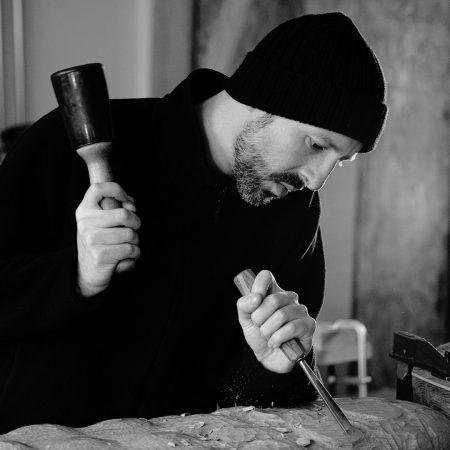
Maxime Perrolle, le bois comme langage artistique
